
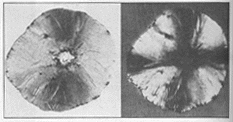 Graphite nodule (left Fig.1) and the same nodule in polarized light (right Fig.2). X1500.
Graphite nodule (left Fig.1) and the same nodule in polarized light (right Fig.2). X1500. Figure 3 Pearlitic nodular iron, as-cast. X200.
Figure 3 Pearlitic nodular iron, as-cast. X200.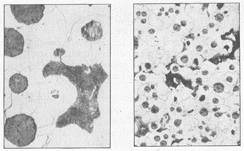 Figure 4-Ferritic nodular as-cast, magnification left X300, right X100.
Figure 4-Ferritic nodular as-cast, magnification left X300, right X100. Figure 5-Ferritized nodular iron, annealed. X300.
Figure 5-Ferritized nodular iron, annealed. X300.| FLAKE GRAPHITE | FERRITIC | FOLIO-GRAPHITO-FERRITIC |
| FLAKE GRAPHITE | PEARLITIC | FOLIO-GRAPHITO-PEARLITIC |
| FLAKE GRAPHITE | ACICULAR | FOLIO-GRAPHITO-ACICULAR |
| FLAKE GRAPHITE | MARTENSITIC | FOLIO-GRAPHITO-MARTENSITIC |
| NODULAR GRAPHITE | FERRITIC | SPHERO-GRAPHITO-FERRITIC |
| (NODULO-GRAPHITO-FERRITIC) | ||
| NODULAR GRAPHITE | PEARLITIC | SPHERO-GRAPHITO-PEARLITIC |
| TEMPER CARBON | FERRITIC | FLOCCU-GRAPHITO-FERRITIC |
| TEMPER CARBON | PEARLITIC | FLOCCU-GRAPHITO-PEARLITIC |
| CARBIDE | PEARLITIC | CARBIDO-PEARLITIC |
 Figure 6 Nodular graphite in malleable iron. X250.
Figure 6 Nodular graphite in malleable iron. X250.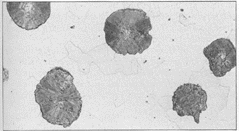 Figure 7-Spheroidal graphite in magnesium-treated iron. X250.
Figure 7-Spheroidal graphite in magnesium-treated iron. X250.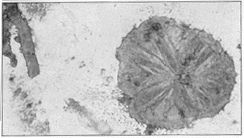 Figure 8-Graphite forms in Mg-Cu treated iron. Unetched. X1000.
Figure 8-Graphite forms in Mg-Cu treated iron. Unetched. X1000.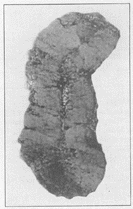 Figure 9-Elongated graphite spherulite in a nickel-carbon alloy treated with strontium-magnesium. Unetched. X1500.
Figure 9-Elongated graphite spherulite in a nickel-carbon alloy treated with strontium-magnesium. Unetched. X1500. Figure 10- Elongated graphite spherulite in a sample of whiteheart malleable iron having sulphur present as FeS. Etched, 4 per cent picral. X150.
Figure 10- Elongated graphite spherulite in a sample of whiteheart malleable iron having sulphur present as FeS. Etched, 4 per cent picral. X150.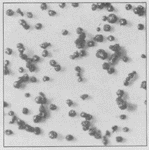 Figure 11-Graphite particles in spherical form were obtained from nodular cast iron by dissolving the iron in dilute acid and treating the residue with hydrofluoric acid to drive off the silica. X100.
Figure 11-Graphite particles in spherical form were obtained from nodular cast iron by dissolving the iron in dilute acid and treating the residue with hydrofluoric acid to drive off the silica. X100.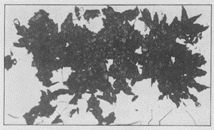 Figure 12-Temper carbon in annealed malleable iron appearing as flake graphite. Etched, 2 per cent nital. X500.
Figure 12-Temper carbon in annealed malleable iron appearing as flake graphite. Etched, 2 per cent nital. X500.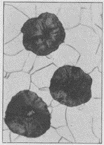 Figure 13-Graphite formation in annealed ductile iron appearing as rounded masses with radial structure. Etched, 2 per cent nital. X500.
Figure 13-Graphite formation in annealed ductile iron appearing as rounded masses with radial structure. Etched, 2 per cent nital. X500. Figure 14-Graphite types in as-cast structure. X250.
Figure 14-Graphite types in as-cast structure. X250.